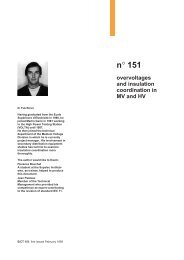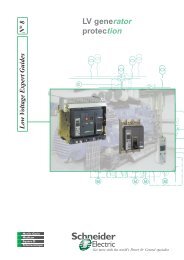sepam 20 user manual - Schneider Electric
sepam 20 user manual - Schneider Electric
sepam 20 user manual - Schneider Electric
Create successful ePaper yourself
Turn your PDF publications into a flip-book with our unique Google optimized e-Paper software.
7<br />
PE801<strong>20</strong><br />
Use SFT2841 setting and operating<br />
software<br />
Configuration of a Sepam network<br />
Configuration window for the communication network via<br />
telephone modem.<br />
7/10<br />
Configuration of called modem<br />
The modem on the Sepam side is the called modem. It must first be configured,<br />
either via AT commands from a PC using HyperTerminal or the configuration tool that<br />
may have been supplied with the modem, or by setting switches (see the modem<br />
manufacturer’s <strong>manual</strong>).<br />
Modem RS 485 interface<br />
In general, the configuration parameters for the modem’s RS 485 interface must be<br />
defined in accordance with the Sepam communication interface configuration:<br />
b speed: 4800, 9600, 19<strong>20</strong>0 or 38400 bauds<br />
b character format: 8 data bits + 1 stop bit + parity (none, even, odd).<br />
Telephone network interface<br />
Modern modems offer sophisticated features such as checking the quality of the<br />
telephone line, error correction and data compression. These options are not<br />
appropriate for communication between SFT2841 and Sepam, which is based on the<br />
Modbus RTU protocol. Their effect on communication performance may be the<br />
opposite of the expected result.<br />
It is therefore highly advisable to:<br />
b Invalidate the error correction, data compression and telephone line quality<br />
monitoring options<br />
b Use the same end-to-end communication speed between:<br />
v the Sepam network and the called modem<br />
v the called modem (Sepam side) and the calling modem (PC side)<br />
v the PC and the calling modem (see recommended configurations table).<br />
Sepam network Telephone network PC modem interface<br />
38400 bauds V34 modulation, 33600 bauds 38400 bauds<br />
19<strong>20</strong>0 bauds V34 modulation, 19<strong>20</strong>0 bauds 19<strong>20</strong>0 bauds<br />
9600 bauds V32 modulation, 9600 bauds 9600 bauds<br />
Industrial configuration profile<br />
The following table shows the main characteristics of the modem on the Sepam side.<br />
These characteristics match a configuration profile commonly known as an<br />
"industrial profile", as opposed to the configuration of modems used in offices.<br />
Depending on the type of modem used, the configuration will either be via AT<br />
commands from a PC using HyperTerminal or the configuration tool that may have<br />
been supplied with the modem, or by setting switches (see the modem<br />
manufacturer’s <strong>manual</strong>).<br />
Characteristics of the "industrial profile" configuration AT command<br />
Transmission in buffered mode, without error correction \N0 (force &Q6)<br />
Data compression deactivated %C0<br />
Line quality monitoring deactivated %E0<br />
DTR signal assumed to be permanently off (allows the modem<br />
connection to be established automatically on an incoming call)<br />
&D0<br />
CD signal off when carrier is present &C1<br />
All reports made to Sepam blocked Q1<br />
Character echo suppression E0<br />
No flow control &K0<br />
PCRED301005EN - 06/<strong>20</strong>08

















